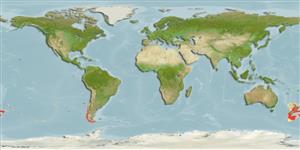分類 / Names
俗名 | 同種異名 | Catalog of Fishes(屬, 種) | ITIS | CoL | WoRMS | Cloffa
Teleostei >
Gadiformes (Cods)
鱈形目 (Cods) >
Merlucciidae (Merluccid hakes)
無鬚鱈科 (Merluccid hakes)
Etymology: Merluccius: Latin, mar, maris = the sea + Latin, lucius = pike (Ref. 45335).
Issue
Reported as M. polylepis in Patagonian waters.
Environment: milieu / climate zone / depth range / distribution range
生態學
海洋 底中水層性; 海洋洄游的 (Ref. 51243); 深度上下限 28 - 1000 m (Ref. 58489). 亞熱帶的; 33°S - 59°S, 165°E - 66°W (Ref. 58452)
Circumglobal in the southern hemisphere (Ref. 7300). Two distinct groups. New Zealand population: Chatham Rise, Campbell Plateau and South Island northward to the East Cape. Patagonian population: Chiloé Island in the Pacific, southward around the southern tip of South America to the continental shelf to 59°S, and the slope north to 38°S in the Atlantic.
環球分佈於南半球.(參考文獻 7300) 二個明顯的群。 紐西蘭族群: Chatham 上升,坎貝爾高地與島南方部向北至東岬。 巴塔哥尼亞族群: 在太平洋的 Chiloe 島,往南南美洲到大陸棚的最南端的周圍對 59個 °S, 與斜坡在大西洋北至 38個 °S 。
Length at first maturity / 大小 / 重量 / 年齡
Maturity: Lm 74.7, range 75 - 85 cm
Max length : 155 cm SL 雄魚/尚未辨別雌雄; (Ref. 58452); common length : 80.0 cm TL 雄魚/尚未辨別雌雄; (Ref. 1371); 最大年齡: 30 年 (Ref. 9072)
背棘 (總數) : 1; 背的軟條 (總數) : 48 - 57; 臀棘: 0; 臀鰭軟條: 40 - 46; 脊椎骨: 53 - 58. Body more slender than other hakes. Pectoral fins long and slender, stripe reaching anal fin in young individuals but not in fish over 50 cm in SL. Gill rakers short and thick with blunt tips. Color is steel gray on back grading to silvery white ventrally.
身體更細長的超過其他的鱈魚。 胸鰭長且細的, 斑紋在幼魚中達到臀鰭但是不在超過 50 的魚公分標準體長中。 鰓耙短與厚的與鈍的頂端。 色彩是鐵灰色的背面漸層色到腹面銀白色的。
Found at depths between 415 and 1000 m in New Zealand waters, and 62 to 800 m in South American waters. The Patagonian population feeds on southern blue whiting, whiptail, nototheniids and squids. The New Zealand population feeds mainly on fishes (especially gadoids), squids, euphausiids and benthic organisms. Adults probably migrate southward during the southern summer for feeding and return to the north in winter for spawning (Ref. 1371). Spawning takes place from August to September on the western coast of South Island, from September to November in the northern part of the Campbell Plateau, and between November and January on Chatham Rise (Ref. 58452). Utilized as food fish and fishmeal.
在南美洲水域的紐西蘭水域 , 與 62 到 800 公尺中發現在深度介於 415 與 1000 公尺之間了。 南美南端地方的族群吃南方的藍色牙鱈,鞭尾蜥蜴, nototheniids 與烏賊。 紐西蘭族群主要捕食魚 (尤其雪科) ,烏賊,磷蝦與底棲的生物。 成魚在南方的夏天期間對於進食可能移動南方而且回到向北冬天時進行產卵。 作為食用魚了與魚粉。
Life cycle and mating behavior
成熟度 | 繁殖 | 產卵場 | 卵 | 孕卵數 | 仔魚
環球分佈於南半球.(參考文獻 7300) 二個明顯的群。 紐西蘭族群: Chatham 上升,坎貝爾高地與島南方部向北至東岬。 巴塔哥尼亞族群: 在太平洋的 Chiloe 島,往南南美洲到大陸棚的最南端的周圍對 59個 °S, 與斜坡在大西洋北至 38個 °S 。
Cohen, D.M., T. Inada, T. Iwamoto and N. Scialabba, 1990. FAO species catalogue. Vol. 10. Gadiform fishes of the world (Order Gadiformes). An annotated and illustrated catalogue of cods, hakes, grenadiers and other gadiform fishes known to date. FAO Fish. Synop. 125(10). Rome: FAO. 442 p. (Ref. 1371)
IUCN 瀕危狀態 (Ref. 130435: Version 2024-1)
人類使用
漁業: 高經濟性
工具
特別的報告
下載 XML
網路資源
Estimates based on models
Preferred temperature (Ref.
123201): 6.2 - 13.3, mean 8.6 °C (based on 112 cells).
Phylogenetic diversity index (Ref.
82804): PD
50 = 0.5000 [Uniqueness, from 0.5 = low to 2.0 = high].
Bayesian length-weight: a=0.00389 (0.00325 - 0.00465), b=3.10 (3.05 - 3.15), in cm total length, based on LWR estimates for this species (Ref.
93245).
營養階層 (Ref.
69278): 4.3 ±0.74 se; based on food items.
Generation time: 5.7 (4.2 - 10.7) years. Estimated as median ln(3)/K based on 15
growth studies.
回復力 (Ref.
120179): 低的, 最小族群倍增時間4.5 - 14 年 (K=0.07-0.19; tm=6-10; tmax=30).
Prior r = 0.24, 95% CL = 0.16 - 0.35, Based on 4 full stock assessments.
Fishing Vulnerability (Ref.
59153): High vulnerability (56 of 100).
Climate Vulnerability (Ref.
125649): High vulnerability (61 of 100).
Nutrients (Ref.
124155): Calcium = 14.6 [5.9, 47.3] mg/100g; Iron = 0.536 [0.198, 1.332] mg/100g; Protein = 17.9 [16.7, 19.0] %; Omega3 = 0.148 [0.083, 0.263] g/100g; Selenium = 84.2 [34.5, 207.6] μg/100g; VitaminA = 11.5 [3.1, 40.8] μg/100g; Zinc = 0.314 [0.198, 0.493] mg/100g (wet weight); based on
nutrient studies.
